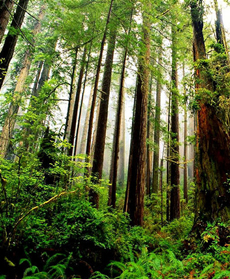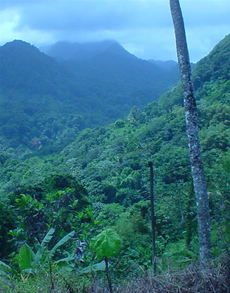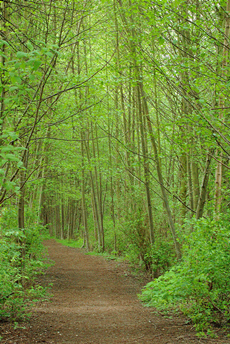Agriculture
Forests are complex ecosystems in which trees are the dominant type of plant. There are three main forest biomes: tropical, temperate, and boreal.
Both humans and animals depend on forests for food, shelter, and other resources. Forests once covered much of the world and are still found from the equator to the Arctic regions. A forest may vary in size from only a few acres to thousands of square miles, but generally any natural area in which trees are the dominant type of plant can be considered a forest.
For a plant to be called a tree, the standard definition requires that the plant must attain a mature height of at least 8 feet (about 3meters), have a woody stem, and possess a distinct crown.
Thus, size makes roses shrubs and apples trees, even though apples and roses are otherwise close botanical relatives. Foresters generally divide the forests of the world into three general categories: tropical, temperate, and boreal.
Tropical Rain Forest
The tropical rain forest is discussed in depth elsewhere. In brief, it is a forest consisting of a dizzying variety of trees, shrubs, and other plants that remain green year-round.
The growth is lush and usually includes both a dense canopy formed by the crowns of the largest trees and a thick understory of smaller trees and shrubs. Growth is often continuous, rather than broken into periods of dormancy and active growth, so that fruiting trees are occasionally seen bearing blossoms and mature fruit simultaneously.
Temperate Forest
The temperate forest lies between the tropical forest and the boreal, or northern, forest. The forests of the Mediterranean region of Europe as well as the forests of the southern United States are temperate forests.
Trees in temperate forests can be either deciduous or coniferous. Although coniferous trees are generally thought of as evergreen, the distinction between types is actually based on seed production and leaf shape. Coniferous trees, such as spruces, pines, and hemlocks, produce seeds in cones and have needle-like leaves.
Deciduous trees, such as maples, poplars, and oaks, have broad leaves and bear seeds in other ways. Some conifers, such as tamarack, do change color and drop their needles in the autumn,while some deciduous trees, particularly in the southerly regions of the temperate forest, are evergreen.
Deciduous trees are also referred to as hardwoods, while conifers are softwoods, a classification that refers more to the typical density of the wood than to how difficult it is to nail into it. Softwoods are lower in density and will generally float in water while still green. Hardwoods are higher in density on average and will sink.
Like tropical forests, temperate forests can be quite lush. While the dominant species vary from area to area, depending on factors such as soil types and available rainfall, a dense understory of shade-tolerant species often thrives beneath the canopy.
Thus, a mature temperate forest may have thick stands of rhododendrons 20 to 30 feet (6 to 9meters) high thriving in the shade of 80-foot (24-meter) oaks and tulip poplars. As the temperate forest approaches the edges of its range and the forest makes the transition to boreal, the understory thins out, disappearing almost completely or consisting only of low shrubs.
Even in temperate forests, the dominant species may prevent an understory from forming. Stands of southern loblolly pine, for example, often have a parklike feel, as the thick mulch created by fallen needles chokes out growth of other species.
Boreal Forest
The boreal forest, which lies in a band across the northern United States, Canada, northern Europe, and northern Asia, is primarily a coniferous forest. The dominant species are trees such as white spruce, hemlock, and white pine. Mixed stands of northern hardwoods, such as birch, sugar maple, and red oak, may be found along the southern reaches of the boreal forest.
As the forest approaches the Arctic, trees are fewer in type, becoming primarily spruce, birch, and willows, and smaller in size.The understory is generally thin or non-existent, consisting of seedlings of shade-tolerant species, such as maple, and low shrubs.
Patches of boreal-type forest can be found quite far south in higher elevations in the United States, such as the mountains of West Virginia. The edge of the temperate forest has crept steadily northward following the retreat of the glaciers at the end of the Ice Age twenty thousand years ago.
Forest Ecology and Resources
In all three types of forest a complex system of interrelationships governs the ecological well-being of the forest and its inhabitants. Trees and animals have evolved to fit into particular environmental niches.
Some wild life may need one resource provided by one species of tree in the forest during one season and a resource provided by another during a different time of year, while other animals become totally dependent on one specific tree.
Whitetail deer, for example, browse on maple leaves in the summer, build reserves of fat by eating acorns in the fall, and survive the winter by eating evergreens. Deer are highly adaptable in contrast with other species, such as the Australian koala, which depends entirely on eucalyptus leaves for its nutritional needs.
Just as the animals depend on the forest, the forest depends on the animals to disperse seeds and thin new growth. Certain plant seeds, in fact, will not sprout until being abraded as they pass through the digestive tracts of birds.
Humans also rely on the forest for food, fuel, shelter, and other products. Forests provide wood for fuel and construction, fibers for paper, and chemicals for thousands of products often not immediately recognized as deriving from the forest, such as plastics and textiles.
In addition, through the process of transpiration, forests regulate the climate by releasing water vapor into the atmosphere while removing harmful carbon compounds. Forests play an important role in the hydrology of watersheds.
Rain that falls on a forest will be slowed in its passage downhill and is often absorbed into the soil rather than running off into rivers and lakes. Thus, forests can moderate the effects of severe storms, reducing the dangers of flooding and preventing soil erosion along stream and river banks.
Threats to the Forest
The primary threat to the health of forests around the world comes from humans. As human populations grow, three types of pressure are placed on forests. First, forests are cleared to provide land for agriculture or for the construction of new homes.
This process has occurred almost continuously in the temperate regions for thousands of years, but it did not become common in tropical regions until the twentieth century. Often settlers level the forest and burn the fallen trees to clear land for farming (slash-and-burn agriculture) without the wood itself being used in any way.
Tragically, the land thus exposed can become infertile for farming within a few years. After a few years of steadily diminishing crops, the land is abandoned.With the protective forest cover removed, it may quickly become a barren, eroded wasteland.
Second, rising or marginalized populations in developing nations often depend on wood or charcoal as their primary fuel for cooking and for home heat. Forests are destroyed as mature trees are removed for fuel wood faster than natural growth can replace them. As the mature trees disappear, younger and younger growth is also removed, and eventually the forest is gone completely.
Finally, growing populations naturally demand more products derived from wood, which can include everything from lumber for construction to chemicals used in cancer research.

Market forces can drive forest products companies to harvest more trees than is ecologically sound as stockholders focus on short-term individual profits rather than long-term environmental costs.
The challenge to foresters, ecologists, and other scientists is to devise methods that allow humanity to continue to utilize the forest resources needed to survive without destroying the forests as complete and healthy ecosystems.
- Types Of Biomes
Types of Biomes The major recognizable life zones of the continents are divided into biomes, characterized by their plant communities. Temperature, precipitation, soil, and length of day affect the survival and distribution of biome species. Species diversity...
- Caribbean Flora
Caribbean FloraThe Caribbean region is noted for its diverse and varied vegetation. Flowers thrive in the moist, tropical environment found on many islands. Hibiscus, bougainvillea, and orchids are just a few of the varieties found there. The heavily...
- Central American Flora
Central American FloraCentral America ? comprising the nations Belize, Costa Rica, El salvador, Guatemala, Honduras, Nicaragua, and Panama ? is a land bridge that connects North America and South America, and many of its plants are similar to plants found...
- North American Flora
North American FloraThe world?s major biomes are all represented in the diverse vegetation of North America, from Arctic tundra in the north to deserts in the Southeast and the grasslands, wetlands, and various forest biomes between. Forest is the native...
- Savannas And Deciduous Tropical Forests
Savannas are areas of continuous grass or sedge cover beneath trees that range from scattered, twisted, and gnarled individuals to open wood lands. Deciduous tropical forests have continuous to open forest cover and undergo a leafless period during a...
Agriculture
Forests
 |
| Forests |
Both humans and animals depend on forests for food, shelter, and other resources. Forests once covered much of the world and are still found from the equator to the Arctic regions. A forest may vary in size from only a few acres to thousands of square miles, but generally any natural area in which trees are the dominant type of plant can be considered a forest.
For a plant to be called a tree, the standard definition requires that the plant must attain a mature height of at least 8 feet (about 3meters), have a woody stem, and possess a distinct crown.
Thus, size makes roses shrubs and apples trees, even though apples and roses are otherwise close botanical relatives. Foresters generally divide the forests of the world into three general categories: tropical, temperate, and boreal.
Tropical Rain Forest
 |
| Tropical Rain Forest |
The growth is lush and usually includes both a dense canopy formed by the crowns of the largest trees and a thick understory of smaller trees and shrubs. Growth is often continuous, rather than broken into periods of dormancy and active growth, so that fruiting trees are occasionally seen bearing blossoms and mature fruit simultaneously.
Temperate Forest
The temperate forest lies between the tropical forest and the boreal, or northern, forest. The forests of the Mediterranean region of Europe as well as the forests of the southern United States are temperate forests.
 |
| Temperate Forest |
Deciduous trees, such as maples, poplars, and oaks, have broad leaves and bear seeds in other ways. Some conifers, such as tamarack, do change color and drop their needles in the autumn,while some deciduous trees, particularly in the southerly regions of the temperate forest, are evergreen.
Deciduous trees are also referred to as hardwoods, while conifers are softwoods, a classification that refers more to the typical density of the wood than to how difficult it is to nail into it. Softwoods are lower in density and will generally float in water while still green. Hardwoods are higher in density on average and will sink.
Like tropical forests, temperate forests can be quite lush. While the dominant species vary from area to area, depending on factors such as soil types and available rainfall, a dense understory of shade-tolerant species often thrives beneath the canopy.
Thus, a mature temperate forest may have thick stands of rhododendrons 20 to 30 feet (6 to 9meters) high thriving in the shade of 80-foot (24-meter) oaks and tulip poplars. As the temperate forest approaches the edges of its range and the forest makes the transition to boreal, the understory thins out, disappearing almost completely or consisting only of low shrubs.
Even in temperate forests, the dominant species may prevent an understory from forming. Stands of southern loblolly pine, for example, often have a parklike feel, as the thick mulch created by fallen needles chokes out growth of other species.
Boreal Forest
 |
| Boreal Forest |
As the forest approaches the Arctic, trees are fewer in type, becoming primarily spruce, birch, and willows, and smaller in size.The understory is generally thin or non-existent, consisting of seedlings of shade-tolerant species, such as maple, and low shrubs.
Patches of boreal-type forest can be found quite far south in higher elevations in the United States, such as the mountains of West Virginia. The edge of the temperate forest has crept steadily northward following the retreat of the glaciers at the end of the Ice Age twenty thousand years ago.
Forest Ecology and Resources
In all three types of forest a complex system of interrelationships governs the ecological well-being of the forest and its inhabitants. Trees and animals have evolved to fit into particular environmental niches.
Some wild life may need one resource provided by one species of tree in the forest during one season and a resource provided by another during a different time of year, while other animals become totally dependent on one specific tree.
Whitetail deer, for example, browse on maple leaves in the summer, build reserves of fat by eating acorns in the fall, and survive the winter by eating evergreens. Deer are highly adaptable in contrast with other species, such as the Australian koala, which depends entirely on eucalyptus leaves for its nutritional needs.
Just as the animals depend on the forest, the forest depends on the animals to disperse seeds and thin new growth. Certain plant seeds, in fact, will not sprout until being abraded as they pass through the digestive tracts of birds.
Humans also rely on the forest for food, fuel, shelter, and other products. Forests provide wood for fuel and construction, fibers for paper, and chemicals for thousands of products often not immediately recognized as deriving from the forest, such as plastics and textiles.
In addition, through the process of transpiration, forests regulate the climate by releasing water vapor into the atmosphere while removing harmful carbon compounds. Forests play an important role in the hydrology of watersheds.
Rain that falls on a forest will be slowed in its passage downhill and is often absorbed into the soil rather than running off into rivers and lakes. Thus, forests can moderate the effects of severe storms, reducing the dangers of flooding and preventing soil erosion along stream and river banks.
Threats to the Forest
 |
| Threats to the Forest |
This process has occurred almost continuously in the temperate regions for thousands of years, but it did not become common in tropical regions until the twentieth century. Often settlers level the forest and burn the fallen trees to clear land for farming (slash-and-burn agriculture) without the wood itself being used in any way.
Tragically, the land thus exposed can become infertile for farming within a few years. After a few years of steadily diminishing crops, the land is abandoned.With the protective forest cover removed, it may quickly become a barren, eroded wasteland.
Second, rising or marginalized populations in developing nations often depend on wood or charcoal as their primary fuel for cooking and for home heat. Forests are destroyed as mature trees are removed for fuel wood faster than natural growth can replace them. As the mature trees disappear, younger and younger growth is also removed, and eventually the forest is gone completely.
Finally, growing populations naturally demand more products derived from wood, which can include everything from lumber for construction to chemicals used in cancer research.

Market forces can drive forest products companies to harvest more trees than is ecologically sound as stockholders focus on short-term individual profits rather than long-term environmental costs.
The challenge to foresters, ecologists, and other scientists is to devise methods that allow humanity to continue to utilize the forest resources needed to survive without destroying the forests as complete and healthy ecosystems.
- Types Of Biomes
Types of Biomes The major recognizable life zones of the continents are divided into biomes, characterized by their plant communities. Temperature, precipitation, soil, and length of day affect the survival and distribution of biome species. Species diversity...
- Caribbean Flora
Caribbean FloraThe Caribbean region is noted for its diverse and varied vegetation. Flowers thrive in the moist, tropical environment found on many islands. Hibiscus, bougainvillea, and orchids are just a few of the varieties found there. The heavily...
- Central American Flora
Central American FloraCentral America ? comprising the nations Belize, Costa Rica, El salvador, Guatemala, Honduras, Nicaragua, and Panama ? is a land bridge that connects North America and South America, and many of its plants are similar to plants found...
- North American Flora
North American FloraThe world?s major biomes are all represented in the diverse vegetation of North America, from Arctic tundra in the north to deserts in the Southeast and the grasslands, wetlands, and various forest biomes between. Forest is the native...
- Savannas And Deciduous Tropical Forests
Savannas are areas of continuous grass or sedge cover beneath trees that range from scattered, twisted, and gnarled individuals to open wood lands. Deciduous tropical forests have continuous to open forest cover and undergo a leafless period during a...
